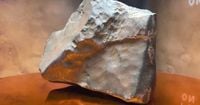In a landmark auction held on July 16, 2025, the largest piece of Mars ever discovered on Earth, a meteorite named NWA 16788, fetched an astonishing $5.3 million at Sotheby's in New York. This extraordinary rock, weighing approximately 25 kilograms (54 pounds) and measuring nearly 15 inches (38.1 centimeters) in length, set a new auction record for meteorites, far surpassing expert estimates that had valued it between $2 million and $4 million.
Discovered in November 2023 by a meteorite hunter in the remote Sahara Desert of Niger, NWA 16788 is not just any space rock. It is roughly 70 percent larger than the next largest Martian meteorite ever found on Earth, making it an exceptionally rare specimen. Sotheby's described the meteorite as "unbelievably rare," noting that among the more than 77,000 officially recognized meteorites worldwide, only about 400 are from Mars, collectively weighing around 374 kilograms. This single piece accounts for approximately 6.5 percent of all Martian material known on Earth.
The journey of NWA 16788 to our planet is nothing short of cosmic drama. It was dislodged from the Martian surface by an asteroid impact and traveled an estimated 225 million kilometers through space before landing on Earth. Cassandra Hatton, vice-chairman of science and natural history at Sotheby's, highlighted the incredible odds of this meteorite's arrival and discovery: "This is the largest piece of Mars on planet Earth. The odds of this getting from there to here are astronomically small." She added, "Remember that approximately 70% of Earth's surface is covered in water. So we're incredibly lucky that this landed on dry land, instead of the middle of the ocean, where we could actually find it."
Physically, the meteorite is covered in a distinctive reddish-brown crust, often referred to as the "unmistakable Martian hue." Its surface features regmaglypts—depressions formed by frictional heating as it rapidly descended through Earth's atmosphere. Experts note that NWA 16788 shows minimal terrestrial weathering, indicating it is a relatively recent arrival on Earth, having fallen from outer space quite recently.
Beyond its monetary value, NWA 16788 offers priceless scientific insights. Martian meteorites like this one allow researchers to study the ancient environment of Mars, including clues about water presence and atmospheric conditions in the planet's distant past. Lauren White, a systems engineer at NASA's Jet Propulsion Laboratory, emphasized in 2014 that "while robotic missions to Mars continue to shed light on the planet's history, the only samples from Mars available for study on Earth are Martian meteorites." Such samples are essential for advancing our understanding of Mars and, by extension, planetary science.
The auction that featured NWA 16788 was a grand event showcasing over 100 rare and valuable items. While the Martian rock made headlines with its record-breaking sale, it was not the top seller. That honor went to a rare dinosaur skeleton—a juvenile Ceratosaurus nasicornis—one of only four known specimens of its kind. This Jurassic-era dinosaur, smaller than the infamous T. Rex but similarly fearsome, sparked a bidding war and ultimately sold for $30 million. Additionally, the skull of a Pachycephalosaurus, known for its thick domed head, fetched $1.4 million.
The identity of the buyer who secured NWA 16788 remains undisclosed, as Sotheby's maintains confidentiality over the sale details. The final bid of $4.3 million was supplemented by approximately $1 million in fees and taxes, bringing the total purchase price to $5.3 million.
This auction not only highlights the growing fascination and value placed on extraterrestrial artifacts but also underscores the intersection of science, history, and commerce. Meteorites like NWA 16788 serve as tangible connections to our solar system's past and inspire both scientific inquiry and public imagination.
As interest in Mars exploration continues to soar, with robotic missions and future sample-return endeavors underway, specimens like NWA 16788 remain invaluable. They are the rarest of cosmic messengers, carrying secrets from millions of miles away and reminding us of the vastness and mystery of space.
Whether destined for a private collection or a museum, NWA 16788’s sale marks a milestone in the story of planetary discovery on Earth, capturing the awe and curiosity that space rocks ignite in all of us.




